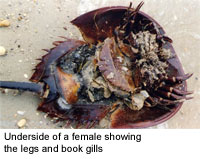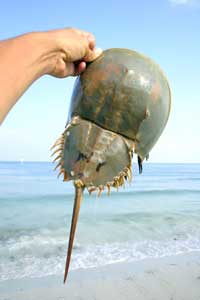|

 Size: They can grow up to 20 inches (51 cm), on a diet of mollusks, annelid worms, and other benthic invertebrates. In captivity, its diet should be supplemented with meaty items such as pieces of squid and shrimp (Foster and Smith, 2004). Its mouth is located in the middle of the underside of the cephalothorax. A pair of pincers (chelicerae) for seizing food are found on each side of the mouth. Size: They can grow up to 20 inches (51 cm), on a diet of mollusks, annelid worms, and other benthic invertebrates. In captivity, its diet should be supplemented with meaty items such as pieces of squid and shrimp (Foster and Smith, 2004). Its mouth is located in the middle of the underside of the cephalothorax. A pair of pincers (chelicerae) for seizing food are found on each side of the mouth.
Book gills: Horseshoe crabs possess five pairs of book gills located just behind their appendages that allow them to breathe underwater, and can also allow them to breathe on land for short periods of time, provided the lungs remain moist.
 Outer Shell: The outer shell of these animals consists of three parts. The carapace is the smooth frontmost part of the crab which contains the eyes, the walking legs, the chelicera (pincers), the mouth, the brain, and the heart. The abdomen is the middle portion where the gills are attached as well as the genital operculum. The last section is the "telson" (caudal spine) which is used to flip itself over if stuck upside down. Outer Shell: The outer shell of these animals consists of three parts. The carapace is the smooth frontmost part of the crab which contains the eyes, the walking legs, the chelicera (pincers), the mouth, the brain, and the heart. The abdomen is the middle portion where the gills are attached as well as the genital operculum. The last section is the "telson" (caudal spine) which is used to flip itself over if stuck upside down.
Eyes: The horseshoe crab has been extensively used in research into the physiology of vision. It has four compound eyes, and each ommatidium feeds into a single nerve fibre. Furthermore the nerves are large and relatively accessible. This made it possible for electrophysiologists to record the nervous response to light stimulation easily, and to observe visual phenomena like lateral inhibition working at the cellular level. More recently, behavioral experiments have investigated the functions of visual perception in Limulus. Habituation and classical conditioning to light stimuli have been demonstrated, as has the use of brightness and shape information by male Limuli when recognizing potential mates.
Among other senses, they have a small sense organ on the triangular area formed by the exoskeleton beneath the body near the ventral eyes.
Mandibles: Although most arthropods have mandibles, the horseshoe crab is jawless. The horseshoe crab's mouth is located in the center of the body. In the female, the four large legs are all alike, and end in pincers. In the male, the first of the four large legs is modified, with a bulbuous claw that serves to lock the male to the female while she deposits the eggs and he waits to fertilize them.
Their body also contains a cartilaginous tissue.
 Regeneration: Horseshoe crabs possess the rare ability to regrow limbs lost, in a manner similar to sea stars. This attribute was recently proven by Sue Shaller of the United States Fish and Wildlife Service. Regeneration: Horseshoe crabs possess the rare ability to regrow limbs lost, in a manner similar to sea stars. This attribute was recently proven by Sue Shaller of the United States Fish and Wildlife Service.
Medical research: Horseshoe crabs are extremely valuable as a species to the medical research community. Since 1964 a substance made from their blood called Limulus Amebocyte Lysate (LAL) has also been used to test for bacterial endotoxins in pharmaceuticals and for several bacterial diseases. The animals can be returned to water after extraction of a portion of their blood, so this is not necessarily a threat to the survival of horseshoe crabs. A single horseshoe crab can be worth $2,500 over its lifetime for periodically drawing its blood for this extract.
Blue blood: The blood of horseshoe crabs is blue, which is a result of its high content in copper-based hemocyanin instead of the iron-based hemoglobin found, for example, in humans. The fact that horseshoe crabs have evolved so little over the past 300 to 400 million years is part of the reason why they are so different from most other animals.
Conservation: Limulus polyphemus is not presently endangered, but harvesting and habitat destruction have reduced its numbers at some locations and caused some concern for these animals' future. Since the 1970s, the horseshoe crab population has been decreasing in some areas, owing to several factors, including the use of the crab as bait in conch trapping.
In 1995, the nonprofit Ecological Research and Development Group (ERDG) was founded with the aim of preserving the four remaining species of horseshoe crab. Since its inception, the ERDG has made significant contributions to horseshoe crab conservation. ERDG founder Glenn Gauvry designed a mesh bag for conch traps, to prevent other species from taking off with the bait. This has led to the amount of bait needed being decreased by approximately 50%. In the state of Virginia, these mesh bags are now mandatory in conch fishery. The Atlantic States Marine Fisheries Commission is in 2006 considering several conservation options, among them being a two-year ban on harvesting the animals affecting both Delaware and New Jersey shores of Delaware Bay.
Every year, around 10% of the horseshoe crab's breeding population dies when rough surf flips the creatures onto their backs, a position from which they often cannot right themselves. In response, the ERDG (Ecological Resource and Development Group) launched a "Just Flip 'Em" campaign, in the hopes that beachgoers will simply turn the crabs back over.
Conservationists have also voiced concerns about the declining population of shorebirds, such as Red Knots, which rely heavily on the horseshoe crabs' eggs for food during their Spring migration. Precipitous declines in the population of the Red Knots have been observed in recent years. Predators of horseshoe crabs, such as the currently threatened Atlantic Loggerhead Turtle, have also suffered as crab populations diminish.

Horseshoe crabs can live for 20-25 years. They migrate into the shore in late spring, with the males arriving first. The females then arrive and make nests at a depth of 15-20 cm in the sand. In the nests, females deposit eggs which are subsequently fertilized by the male. Egg quantity is dependent on female body size and ranges from 15,000-64,000 eggs per female (Leschen et al. 2006). "Development begins when the first egg cover splits and new membrane, secreted by the embryo, forms a transparent spherical capsule" (Sturtevant). The larvae form and then swim for about five to seven days. After swimming they settle, and begin the first molt. This occurs approximately twenty days after the formation of the egg capsule. As young horseshoe crabs grow, they move to deeper waters, where molting continues. They reach sexual maturity in approximately eleven years and may live another 10-14 years beyond that.

Horseshoe crabs are distant relatives of spiders and are probably descended from the ancient eurypterids (sea scorpions). They evolved in the shallow seas of the Paleozoic Era (540-248 million years ago) with other primitive arthropods like the trilobites. Horseshoe crabs are one of the oldest classes of marine arthropods, and are often referred to as "living fossils", as they have not changed much in the last 350 to 400 million years.
All text is available under the terms
of the GNU Free Documentation License
|